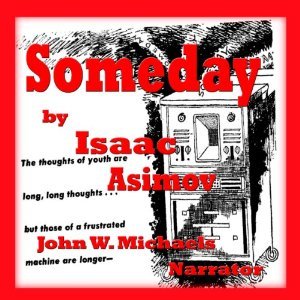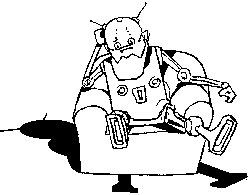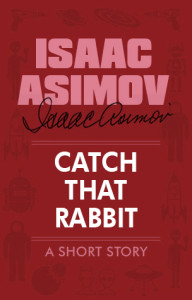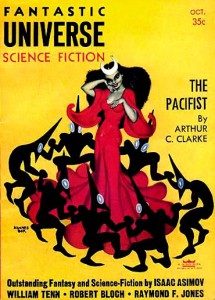| Order Now from Amazon | |
| 1 | The Bicentennial Man |
| 2 | Satisfaction Guaranteed |
| 3 | First Law |
| 4 | Catch the Rabbit |
| 5 | Light Verse |
| 6 | Someday |
Isaac Asimov is undoubtedly one of the most influential science fiction writers in our history. During his lifetime, he produced countless books and short stories speaking of galaxies, humans invading planets, a radioactive Earth, robots that can feel, and so much more. He was able to create one whole universe, origins, and legends. Despite the gravity of depth of his works’ setting, he never failed to give it a human touch – something that makes humans, well, humans.
Most of his famous works are books, but he has written short stories that do not need length to make the reader think and more importantly, wonder about what’s out there or what are the things that are yet to happen.
We’ve seen it before in movies – humans creating robots, robots evolving on their own, robots killing humans, humans killing robots and humans… you know the drill. Asimov – take note that this happened in the 1930’s – started crafting images of these robots in his mind and started asking endless what if’s. What if humans fell in love with robots? What if robots want to become humans? What if robots suddenly feel anxious?
Isaac Asimov’s “The Complete Robot” is a collection of Asimov’s 31 out of 38 short stories. The book was published in 1982 though the works included in the collection were written between 1939 and 1977. The stories in the book are not connected with each other and can work as standalone stories. However, they share a common theme: The connection between robots and humans.
 The resounding theme of human-robot relationship stirs a lot of, issues and complexities in the overarching subject of morality, culture, and humanity. Overall, these are the things that made the stories great. They’re short, well-written, and they give you a certain kind of excitement. They don’t give you the “Eureka!” moment. Instead, they give you the most relevant point in time: the “Wait, that’s funny…” moment.
The resounding theme of human-robot relationship stirs a lot of, issues and complexities in the overarching subject of morality, culture, and humanity. Overall, these are the things that made the stories great. They’re short, well-written, and they give you a certain kind of excitement. They don’t give you the “Eureka!” moment. Instead, they give you the most relevant point in time: the “Wait, that’s funny…” moment.
By reading Asimov’s collection of short stories, you will start to wonder, to ask, to look for more – not so you can build robots (though that may also be done), but to learn more about yourself as a human being and to find out more about our species as creatures that think, feel, dream, cry, and love.
This article features 10 of Asimov’s short stories from “The Complete Robot” that will make you revel in awe and wonder. Warning, though! If you’re planning to read the stories, this article contains a lot of SPOILERS.
6. Someday (1956)

Human hysteria over robot attacks is a major theme in all of Asimov’s books. When you start asking these types of questions, you’re just either scared for your species and you would want to stop the rise of the robots, or you would push for the advancement of human beings who can co-exist in peace with robots.
Much like today’s world, “Someday” is set at a time where computers are the primary tool for organizing human’s lives. Since most of the thinking and computing are done by machines, humans are just trained to be computer operators, thus, reading and writing were eliminated from the school curriculum.
The story revolves around a pair of boys who decided to dismantle and study an old Bard, a former computer model created to read fairy tales to children.
The children downloaded a book file into the Bard’s system and tried to expand its abilities. When this failed, they decided to run to the nearest library to learn how to read and write so that they can pass secret messages to one another.
The story ended with a rather eerie feeling when the Bard started to recite a dark fairytale about an ignored and ridiculed robot named Bard, which was made to tell stories. Bard ends the story with rather creepily: “the little computer knew then that computers would always grow wiser and stronger until someday – someday – someday…”
Admit it, the story sounds like something from Twilight Zone. Again, with his usual Asimov fashion, readers are left asking “What if?” What if robots become stronger than humans?
5. Light Verse (1973)

Isaac Asimov sure knows how to play with different genres – he can do comedy, drama, and of course, suspense thrillers.
After receiving a generous pension from her husband’s death, Mrs. Lardner invested her money and became a wealthy, famous artifact collector and light-sculptor. Though many have shown interest in her collection and original works, she turned them down.
Mrs. Lardner was also known for her crew of robots who worked in her household as guards of her collection and valuables. What makes them unique is how they’re not readjusted. When asked why she never had her crew adjusted, she insisted that their imperfection is what makes them lovable.
John Travis was a fan of Mrs. Lardner’s works. He was known as the roboticist who kept on imitating her light sculptures and failed over and over. Wanting to impress her, he attended one of her parties and deeming it as an act of kindness and gratitude, fixed one of Ms. Lardner’s robots, Max.
Here’s the catch: When Mrs. Lardner found about what he did to Max, she revealed that it was Max’s malfunction that allowed him to create the light-sculptures. After her rage, she murdered John with her jeweled knife. This story shows a lot of things about humanity and what makes humans unique.
In post-investigations, the police noticed that there were no signs of resistance from Max when he was murdered by Mrs. Lardner. Would it possible that Max allowed Mrs. Lardner to kill him? In Asimov’s explanation of this piece, he explains that one human trait that can either give a person a full life or kill him mercilessly. Asimov was talking about passion.
John Travis spent his days imitating Mrs. Lardners perfect light sculptures. During their encounter, he finds out that he’s apparent been trying to defeat a robot. He allows Mrs. Lardner to kill him because he has lost what he was fighting for – to be the best light sculptor in human history.
4. Catch that Rabbit (1944)

Isaac Asimov didn’t stop at the superficial level of human and robot differences. He also took into account the possibility of robots being able to feel human emotions and psychological troubles. This is evident in Catch, the Rabbit.
A team was running asteroid field tests when their robot, Dave, stops producing ore. Dave is a new model and roboticists aren’t fully aware of its bugs yet. It heads other robots, represented by his fingers.
The team observes Dave find out why he’s not performing his tasks. In the end, they realize that it’s a Heisenbug; a software problem that’s causing Dave to get confused and pressured to make decisions because he has a lot of subsidiary robots under his control. When orders are sent to Dave, he delivers multiple tasks to his subsidiary out of indecisiveness.
Asimov created a new angle here: What happens when robots feel pressured out of a role? He was trying to parallel the human psyche with the robot psyche and has successfully shown how, as humans, robots can malfunction when leading teams, and may succeed when the responsibility is passed to someone else.
3. First Law (1956)

This is one of Asimov’s shortest pieces. It questions a robot’s ability to rule over the Law of Robotics for its beliefs and feelings.
In this story, Mike Donovan shares an encounter with a malfunctioning robot, Emma. They were on one of Saturn’s moons, Titan, when they realized they were stranded in a storm. Instead of protecting Donovan, Emma chooses to protect her offspring which she built.
Here, it is clear that Asimov is looking at the possibility for a female robot to have maternal instincts. What’s spectacular about Emma is the fact that she created her offspring. Out of nothing, she built something she would relate to as a child. Much like how motherhood is, Emma chooses to dismiss the first law of robotics and protect her child instead – something very human.
2. Satisfaction Guaranteed (1951)
Humanoid household robots are common themes in science fiction. It’s not the first time that someone touched on the possibility of robots getting too attached to humans. Asimov often looked at this angle in his stories.
This short story stars Tony, a humanoid household robot, who works for Claire Belmont. Claire’s husband works for US Robots and is, naturally, very busy.
It doesn’t take Tony a long time to realize that Claire has low self-esteem. He tries to fix this by decorating the house and treating her to a much-needed make-over. Seeing that what he’s doing is working, he steams it up by pretending to be Claire’s lover and deliberately letting their neighbors see them kiss. In the end, Claire falls in love with Tony.
Claire, being a wife who was always left out, found satisfaction in Tony. One cannot say if the playing ground was fair between the robot and her husband since Tony was programmed to make his masters happy. Claire’s reaction towards Tony’s actions, however, are very human – frailty and submission for attention and significance.
An unfortunate string of events forced Tony to go back to the lab, and Claire is left in love with a robot and depressed.
1. The Bicentennial Man (1976)

This short story has got to be one of Asimov’s most famous one. “The Bicentennial Man” boasts two awards: the Hugo Award and the Nebula Award for Best Science Fiction Novelette. The book, The Positronic Man (1993) was based on this short story. It was brought to the big screen in the 1999 film, Bicentennial Man where Andrew Martin was played by the late Robin Williams.
Andrew Martin is a robot butler. Though he was made to serve the humans, he became incredibly close to the patriarch of the family and his youngest daughter, whom Andrew refers to as “Little Miss.”
It doesn’t take the father – referred as “Sir” – to realize that there’s something different about Andrew. Andrew, though a programmed robot, has an intricate skill on woodcarving. He even read books on woodwork and challenges himself to create more complicated figures.
Sir finally falls into his curiosity for Andrew’s talent when the robot uses the word “enjoy” to describe why he carves. Sir and Andrew builds a woodcarving business. Eventually, Andrew saves enough money to be able to pay for something he always wanted – body upgrades.
He had everything altered, and the updates gave him some human traits. Little Miss grows up and gets married. She gives birth to her child, Little Sir. With Little Sir’s arrival, Andrew feels that he can now purchase the next thing he wanted the most – his freedom. Sir gives Andrew his freedom. Not long after, he passes away, with the robot beside his deathbed.
As years pass, Andrew gets more committed to becoming human. The ultimate decision to completely remove any trace of his robotic life comes when he asks a robotic surgeon to alter his positronic brain so that he will age and eventually die. With this sacrifice, the World President signs a law officially recognizing Andrew Martin, a human. The declaration was made on his 200th birthday.
The overarching theme of human-robotic relationships resounds mostly on “Bicentennial Man.” What’s magical about this piece is how Little Miss gave a robot its name, Andrew. Little Miss gave him an identity, the first thing a human is given during his/her birth. She then builds a good kind of friendship with Andrew, about him as her best friend.
Not long after, Sir gives Andrew a hobby or some passion. Though a robot, he doesn’t dabble with math or science. Instead, he gets into art – the very essence of liberty and art in the human life. “Bicentennial Man” was translated into a movie in 1999. In the film, he had the chance to meet with the World President for the last time to convince her to acknowledge him as a man.
The World Leader asks him why becoming a man is so important to him. In front of the different nations’ leaders, he answered, “To be acknowledged for who and what I am, no more, o less Not for acclaim, not for approval, but, the simple truth of that recognition. This has been the elemental drive of my existence, and it must be achieved if I am to live or die with dignity.”

